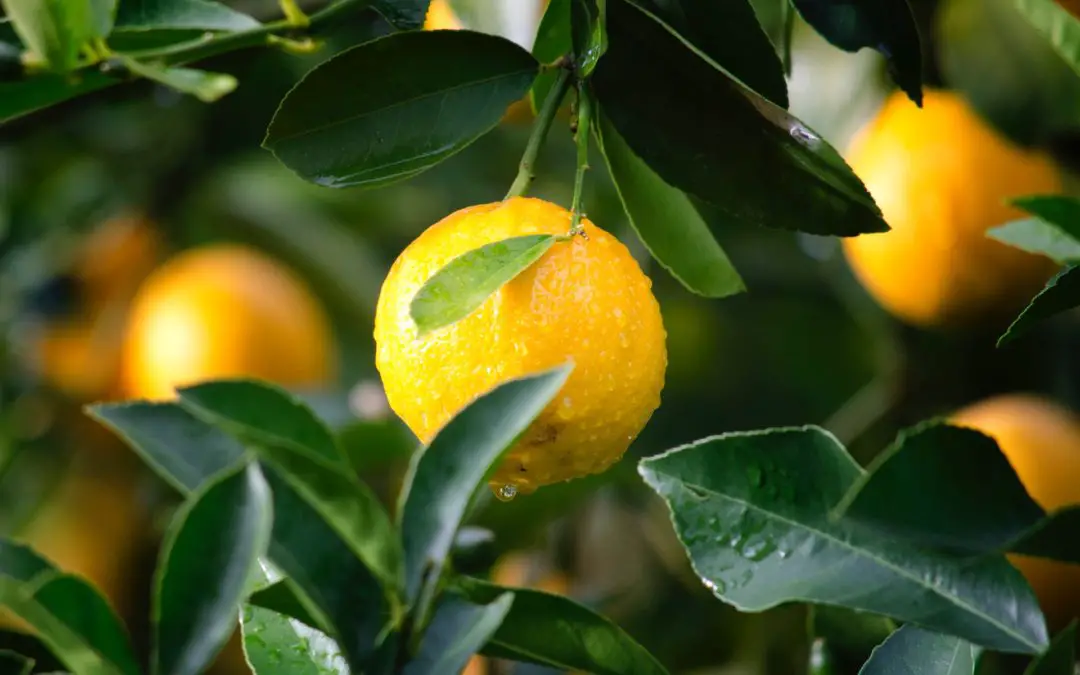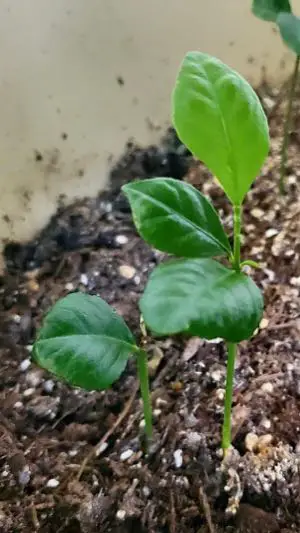Do lemon trees have thorns?
Yes, many cultivated and wild species of lemon trees have thorns. Citrus trees have evolved thorns to protect from herbivores, as a mechanical means of defence.
Human plant breeders have tried to breed thorns out of different varieties of lemons with some good success. In some cases there is a bit of a trade-off, varieties that are bred for reduced thorns don’t have as delicious and large fruit.
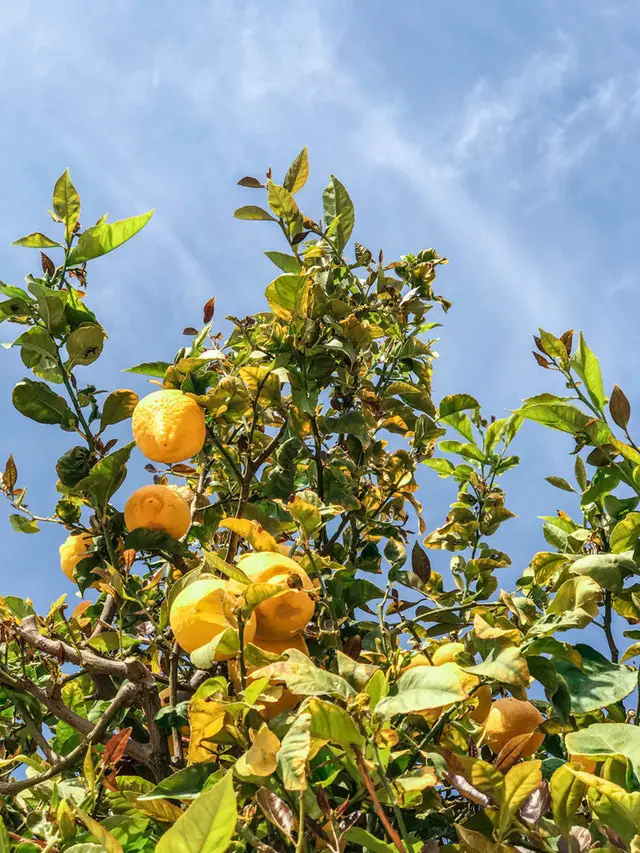 Citrus trees of all kinds can have thorns, this includes:
Citrus trees of all kinds can have thorns, this includes:
- Oranges
- Mandarins
- Pomelos
- Grapefruits
- Lemons
- Limes
- Tangelos
And many more. Over time, the more popular commercial varieties, have been bred to reduce thorns for easier cultivation.
Lemon trees you commonly find today at a nursery are of a few varieties. Eureka is a common one which has been bred for reduced thorns, they’re almost thornless. Meyer is another common one, and they can have thorns or not.
Lemon thorns can be really prolific, and as long as 6 inches (15 cm) on larger trees! The thorns are common on younger shoots, where the vegetation is at higher risk of getting munched by a herbivore.
To the right/below is a lemon tree seedling. It doesn’t have thorns yet! Photo courtesy of my friend Kyle, If you’re interested in Gold Prospecting and all things Outdoors, check out his YouTube channel Utmost Outdoors.
How to remove thorns from a lemon tree
Removing thorns from a citrus tree is no problem. Pruning them won’t damage the tree. It’s always a nice idea to use clean tools to lower the chance of spreading disease. If you’re doing it at home, give your shears or pruners are quick wipe with rubbing alcohol or a disinfectant and you’re good to go.
A good reason to remove thorns is when grafting. The stock (root-portion) and scion (vegetative/trunk) should have thorns removed near the graft so you can properly seal and secure it so it heals.
Another great option is to snip the sharp tips off the thorns if you want to preserve the thorny look. You can use garden shears, or nail clippers work great too.
Which citrus trees have thorns?
To answer this I’ve scoured the web to figure out which types of citrus trees usually have thorns and which don’t. There are hundreds of species and cultivars of citrus, but some of the more common ones are listed in the table below. Latin/scientific name in parentheses.
| Have Thorns | No Sharp Thorns* |
|---|---|
| Meyer Lemon (Citrus x meyeri) | Eureka Lemon (Citrus limon) |
| Lisbon Lemon (Citrus Limon) | Bearss Lemon (Citrus limon) |
| Blood Lime/Australian Red Centre Lime (Citrus australasica var. sanguinea x 'Ellendale Mandarin') | Tahiti Lime (Also Called Persion Lime) |
| Pink Variegated Lemon | Fallgo Tangerine (Reticulata x Sinensis) |
| Grapefruits (Citrus paradisi) | Dancy Tangerine (Citrus reticulata |
| Key Lime/Mexican Lime (Citrus × aurantiifolia) | |
| Pomelo/Pumello (Citrus maxima) | |
| Tangelos (Citrus x tangelo) | |
| Sweet Kumquat (Citrus japonica) | |
| Mandarin Orange (Citrus reticulata) | |
| Ponderosa Lemon | |
| Sweet/Navel Orange (Citrus x sinensis) | |
| Blood Orange (citrus x sinensis) | |
| Kaffir Lime (Citrus hystrix) | |
| Australian finger lime (Citrus australasica) |
*No sharp thorns isn’t a guarantee. Citrus varieties are constantly evolving, and specific genetics vary by location and nursery. Also many “thornless” varieties of citrus aren’t truly thornless, but have smaller rounder thorns (usually at nodes and near leaves). Also you may have a thornless variety that’s been grafted onto a thorny root stock (for disease prevention and hardiness). If you have thorns when you weren’t expecting them: carefully inspect to see if they’re coming from a grafted rootstock. And remember: you can always prune thorns with no issue.
Why do citrus trees have thorns?
Thorns originally evolved on citrus trees to protect from herbivores. Citrus are often thorniest when young tender vegetation is growing, making them less attractive for animals to eat. Young tender plants are more desirable for animals, but it can make harvesting fruit a bit more challenging.
Many citrus, including lemons, have thorns. Humans have diversified citrus into many different species and cultivars through the years, and this is an ongoing process.
So why haven’t we bred thorns out of citrus completely?
Before humans, there were only a handful of different citrus. While it is desirable to have less thorns on citrus for harvesting purposes, many thorn-less cultivars aren’t as productive and produce lower quality fruit (src). This is an on-going challenge, and I suspect one day citrus will barely have any thorns at all. But for now, fruit productivity and taste is more important than a bit more difficulty with harvesting, so we’re stuck with thorns, at least for now.
Thornless varieties of lemon
So what thornless varieties are available?
If you’re looking for a lemon tree that’s child friendly, or just a bit easier on the hands, try out Bearss Lemons or Eureka Lemons.
Bearss Lemon and Eureka Lemon have been bred to reduce sharp thorns. They may still have small thorns or blunt thorns near the leaves, but shouldn’t have the long sharp thorns characteristic of most lemon varieties.
Thornless varieties are often said to be less flavorful than other varieties, but I haven’t found this to be the case. Eureka and Bearss lemons are popular for good reason, they taste great.
What kind of lemon tree do I have?
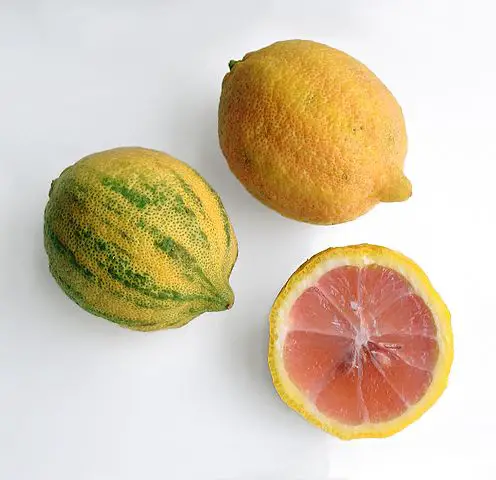
Distinguishing between a lemon tree and a lime tree is a good first step. There are some key features that are different between the two. Most lemon fruits are yellow, or variegated. Variegation is an alternating pattern of colors. For Lemons it’s usually yellow with light green. Limes are generally smaller, and lime green!
You can get hints on the type of citrus you have from a few things. The size of the fruit, the color of the rind and the flesh, growth habit, leaves, flowers and overall shape of the tree. But it’s not always as simple as it might seem. For example you might expect a lemon fruit to have a yellow rind with light yellow flesh. But that’s not always the case! The photo to the right (source) is a stunning counter-example.
You can see the pink flesh which might make you think of a grapefruit, and the variegated yellow and green rind, which is tough to place!
Are lemon tree thorns poisonous?
The thorns don’t contain any particularly harmful compounds and definitely not poisons.
But that doesn’t mean they can’t cause medical problems. See a doctor or properly trained medical professional if you have any reason to believe you might have a medical issue.
The thorns can puncture your skin. This can introduce micro-organisms that can cause infection or irritation. The thorns also can scrape oils and other things from the fruits of the lemon tree. These oils can be painful and irritate cuts.
The fruits and vegetative parts of the plant do contain compounds that are toxic to Dogs, Cats, and Horses according to the American Society for the Prevention of Cruelty to Animals. The toxic parts are the essential oils and psoralens. Luckily, pets aren’t attracted to lemons, they usually hate the sour and bitterness of the peels, so they stay away on their own!
Do citrus thorns prevent fruit?
No, thorns on a citrus plant are nothing to worry about, your plant will still produce fruit. In fact, most wild citrus plants have thorns, it’s just through selective breeding that breeders have been reducing thorns over time.
But! If your citrus plant is grafted you’ll want to watch out. Grafted means you’re growing a certain variety of citrus on the roots of another plant. If your fruiting scion (top plant) or cultivar is a low or no thorn type, but there are thorny shoots from the root-stock of your plant, you’ll want to cut those off. Look for a change in bark, and a healed ‘wound’ where the two plants have grown together.
The point of the grafting is to use rootstock that is hardy, well adapted for your soil, and resistant to disease.
The plant is expending energy growing vegetative tissue for the rootstock, and it won’t grow the fruit you’re expecting (if at all).
Younger vigorous growing shoots are often thorniest.
What is the function of thorns on a lemon plant?
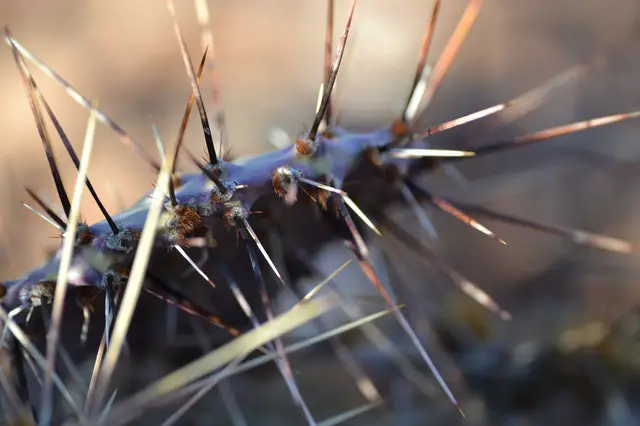 Thorns are an evolutionary adaptation that benefits plants in a number of ways. Thorns are present on citrus trees likely to prevent foraging animals from eating the leaves.
Thorns are an evolutionary adaptation that benefits plants in a number of ways. Thorns are present on citrus trees likely to prevent foraging animals from eating the leaves.
They’re a mechanical means of defense against herbivores.
Thorns also evolved on desert plants, in place of leaves. The large surface area of leaves allows a lot of water to evaporate. So over time as the plants evolved to move in to dryer and dryer climates. Thorns can help shade desert plants and conserve water.
Do wild lemon trees have thorns?
Yes, wild species of lemon trees usually have thorns.
Lemon trees can be cultivars (variants produced by human breeding) or the species. The wild lemon trees are species, unless it’s a cultivar that’s been reintroduced to nature. A cultivar is a cross between species and cultivars or two cultivars with the goal of some desired trait (usually aesthetics or delicious juicy fruit).
A species is sort of the same idea, but it occurred in nature through a more random evolution. The species ultimately stabilized to occupy a new niche. With evolution and natural sexual reproduction introducing slight tweaks every generation.
How much sun do citrus trees need?
Citrus trees are often sensitive to cold, and prefer a lot of light. They like around 8 to 12 hours of sunlight a day, so it can be challenging to keep them happy if you’re trying to grow them indoors and don’t have a lot of light. Opt for a south-facing window if you have one, skylights are a great source of indirect light as well.
Sunlight can have an indirect impact on thornyness. More light usually means a healthier plant, and that means more young vegetative growth. The younger growth is often thornier than older growth.
Conclusion
Most lemon trees, and most other citrus have thorns. Even thornless varieties are often grafted on thorny root stalk. You can prune lemon and other citrus tree thorns without damaging the plant, and you may actually protect the fruit from further damage by removing thorns. If you truly want a less thorny lemon, try Eureka or Bearss lemon varieties, when in doubt, ask your local nursery!

I’m Alex Lafreniere. I learned a lot about plants when I built and operated a landscaping company. But, there’s always more to learn. Ever since travelling across the world, I’ve wanted to find ways to bring more tropical and exotic plants into my life. This is the site where I share everything I’ve learned with you.
This site is owned and operated by Plant Hardware, a sole proprietor headquartered in Calgary, Canada. Plant Hardware is a participant in the Amazon Services LLC Associates Program, an affiliate advertising program designed to provide a means for sites to earn advertising fees by advertising and linking to Amazon.com.Plant Hardware may also participate in affiliate programs with Bluehost, Clickbank, CJ, ShareASale, and other sites. Plant Hardware is compensated for referring traffic and business to these companies.

